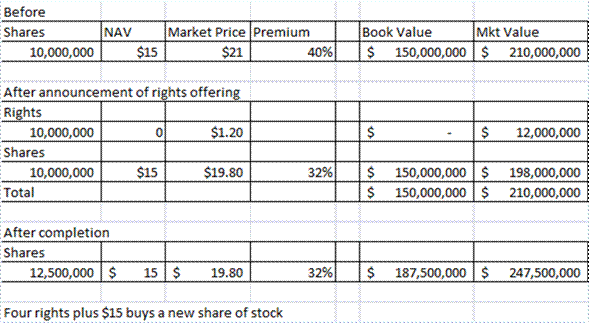Photo Credit: Matt M. || Some things are just too big for their own good.
Three years ago, I wrote an unusual piece called “How do you Manage a Company when the Stock is Considerably Overvalued?” Part of it dealt with the simpler case of dealing with closed-end funds that trade at a consistent premium to NAV. Quoting that portion of the article:
…what should a the managers/board of a closed end fund do if it persistently trades at a large premium to its net asset value [NAV]? ?I can think of three ideas:
1) Conclude that the best course of action is to?minimize the eventual price crash that will happen. ?Therefore issue stock as near the current price level as possible, and use it to buy non-inflated assets, bringing down the discount. ?What?s that, you say? ?The act of announcing a stock offering will crater the price? ?Okay, good point, which brings us to:
2) Merge with another closed end fund, trading at a discount, but offering them a premium to their NAV, hopefully a closed end fund?related to the type of closed end fund that you are. ?What?s that, you say? ?Those that manage other closed end funds are financial experts, and would never agree to that? ?Uhh, maybe. ?Let me say that not all financial experts are equal, and who knows what you might be able to do. ?Also, they do have a duty to their investors to maximize value, and for those that?sell above net asset value this is a big win. ?In the meantime, you have reduced your effective economic discount for those that continue to hold your fund.
3) Issue bonds or preferred stock convertible into common stock at a level that virtually guarantees conversion. ?Use the proceeds to invest in your ordinary investment strategy, bringing down the effective discount as dilution slowly takes place.
Of all the ideas, I think 3 might work best, because it would have the best chance of allowing you to issue equity near the overvalued level. ?If the overvaluation was 50%, maybe you could get it down to 25% by doubling the asset base, in which case you did your holders a big favor. ?If it works, maybe repeat it in two years if the premium persists.
How do you Manage a Company when the Stock is Considerably Overvalued?
Tonight, I want to suggest a fourth method, which would work and for the most part not upset existing holders. It would also benefit the fund manager. Do a rights offering.
A rights offering would give each shareholder a certain number of rights per original share held, allowing them to buy shares of stock at a price lower than the current price at the time of the announcement. The rights are typically tradeable, so someone not wanting to put more money in can trade their rights away — to them it is like a dividend. Others can buy the rights traded away, and buy shares in the offering. There are sometimes “oversubscription rights” which allow those subscribing in the rights offering to get additional shares at the offering price pro-rata to their subscriptions, if there are shares not purchased in the rights offering. Finally, rights not exercised expire worthless on the closing date of the offering.
Sound like a fun game? I participated in a number of these in the ’90s, particularly with some small-cap mortgage REITs that were busted from playing around with interest only securities using borrowed money. Messy stuff, but they had tax losses that were worth more than the price of the stock. The rights offerings were a means of raising capital to give them breathing room so that they could wind up their operations on more favorable terms than a forced sale that would endanger the value of the tax losses. But I digress…
Rights offerings are typically a small-cap phenomenon. They are one of the financing methods of last resort. But they could play a meaningful role in bringing down the premium over NAV of a closed-end fund.

In this case, every old share receives one right, and it takes $15 plus four rights to buy a new share. The above assumes that all rights are used, and all the additional 2.5 million shares are subscribed.
Two things happen: the closed-end fund gets bigger, and the premium to NAV drops. Now, there is no guarantee that the price would not be affected by the rights offering — some people might mistakenly sell out in a panic, or the shareholders might bid up the price back to $21, illogical as that might seem. But if everyone behaved rationally in an offer like this, the premium over NAV would fall, and more so if fewer rights were needed to buy a share.
Now the managers of the fund would have more assets to manage, but might find that they can’t absolutely replicate the prior composition of the fund — many funds that trade at a premium are relatively high yielding bond funds. It’s possible that as a result of the additional money to put to work that the yield of the fund might fall, inducing some people to sell, and the premium to NAV would drop further.
It would be in the interests of the managers to try something like this to monetize the premium of the fund. If fund investors are rational, they wouldn’t lose any money in the process. But would the managers ever try doing it? Time will tell.

